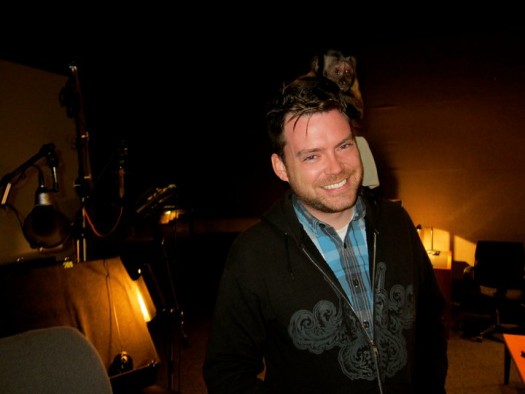Lee Gilmore | Sound Designer

Photo: Lee pictured at Warner Bros., during recording for “The Hangover Part II.” Look closely over his left shoulder—that’s Crystal, the scene-stealing monkey (“A sweetheart,” says Lee)!
Lee was part of the team led by sound editor/designer Paul N. J. Ottosson, whose efforts were recognized at the 2013 Academy Awards with the Oscar for Best Sound Editing (in a rare tie, with Skyfall). In the sound categories, the specific on-stage, statue-holding recognition goes to the supervising sound editor; Ottosson is now a three-time Oscar victor (he previously won sound mixing and sound editing for The Hurt Locker). Ottosson had previously worked with Gilmore on the apocalypse thriller 2012, and hired him again for ZDT, which turned about to be an intense, and rewarding, challenge.
According to Lee, “On the effects side of the crew we had Paul supervising and designing. He also went on to mix the show himself. Jamie Hardt [credited with additional sound design] and I were the effects editors. It was a seven-reel movie [a little longer than average] and we basically split the show in half. I took care of most of the middle of the movie and Jamie was in charge of doing the raid on Bin Laden’s house. He designed some really great helicopters, had great door explosions and fantastic assault rifles. We’d cut our reels and Paul would come in for playbacks, give us notes, different perspectives on how to approach things, etc.
“During ‘Zero,’ Paul always stressed that he wanted it to sound ‘really real.’ Over-the-top summer blockbuster sounds were not going to work for this type of project. It needed to sound grounded in reality and that allowed the movie to play much more gritty, uneasy and tense. You would think that overdoing it on bombastic sound effects would lead to these reactions, but it seems audiences are subconsciously desensitized to those types of sounds these days. Sometimes by keeping your ideas basic and raw it really can sell ‘unnerving’ and ‘real.’
“One of my favorite things to cut is backgrounds. I’m obsessed with them because there is such nuance involved. You can sneak in so many subtle things and really set the tone for a scene. A particular scene that comes to mind is at Camp Chapman, when one of the main characters is outside an army bungalow waiting for her contact to show up. I kept the backgrounds very alive at first, distant Humvees, C130’s flying overhead, etc., and tried to sell the fact that we were in a lively location filled with people. She ends up waiting all afternoon and her contact still hasn’t shown. To help sell the passage of time, the next time we see her most the activity has died down and the base is portrayed as much more lonesome. The idea was that the audience begins to feel uneasy that the contact might not show. I started to play with desert winds slowly rolling in, followed by sand in the wind hitting different surfaces around the base, halyards tinkling on a flagpole, weird metal creaking for a distant shed, and camo nets flapping in the wind–just subtle, non-obtrusive sounds that were gradually escalating to give the audience a subliminal build up. When her contact finally shows up we find out he’s in fact a suicide car bomber. Before he sets off his car bomb I pulled back on all the background activity that had slowly been building up to give us a little hole of silence before the explosion. The only thing we hear in that hole are the escalating ticks of his car engine cooling off. I had a lot of fun cutting the explosion and making it as concussive and shocking as I could.”
Lee moved to Los Angeles shortly after graduation and has worked steadily as a sound effects editor ever since, at Sony Pictures Entertainment, NBC Universal and currently at Warner Bros. Among his film credits are Gangster Squad, The Amazing Spider Man, The Hangover Part II, and Water for Elephants. Right now he’s working on The Hangover Part III. He says, “I spent the fall doing Zero Dark Thirty, and small stints on White House Down and A Good Day to Die Hard, so it’s nice to be working on a comedy.”
The Jackson, Mississippi native attended three colleges before settling at Watkins and once he did, “school just really clicked. I enjoyed the underdog atmosphere of the school and the fact that most teachers were friends and incredibly approachable. The plan was to get into picture editing. During one my final editing classes our teacher, Denine Rowan, took our class to New York to learn more about post-production. I sat in with some music editor friends of hers for the day, and [t]hat’s when I really started to pay attention to sound, and enrolled in Watkins’ sound class that next semester…[I] was hooked on sound effects from that day on.”